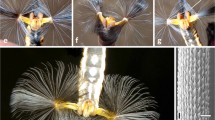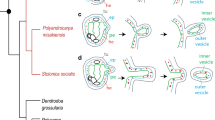Abstract
Hypodermal gland cells in Raillietiella sp. represent a new cell type in pentastomids. They were discovered in infective larvae (intermediate host) and in juvenile raillietiellids (final host) during molting. The ultrastructural development of hypodermal gland cells is described in this report. We think that hypodermal gland cells are class 1 gland cells, which form temporary cilia during molting. Their possible function as releaser-pheromone gland cells is discussed.
Similar content being viewed by others
Author information
Authors and Affiliations
Additional information
Received: 7 June 1996 / Accepted: 21 August 1996
Rights and permissions
About this article
Cite this article
Stender-Seidel, S., Thomas, G. & Böckeler, W. Investigation of different ontogenetic stages of Raillietiella sp. (Pentastomida: Cephalobaenida): hypodermal gland cells. Parasitol Res 83, 269–272 (1997). https://doi.org/10.1007/s004360050245
Issue Date:
DOI: https://doi.org/10.1007/s004360050245




